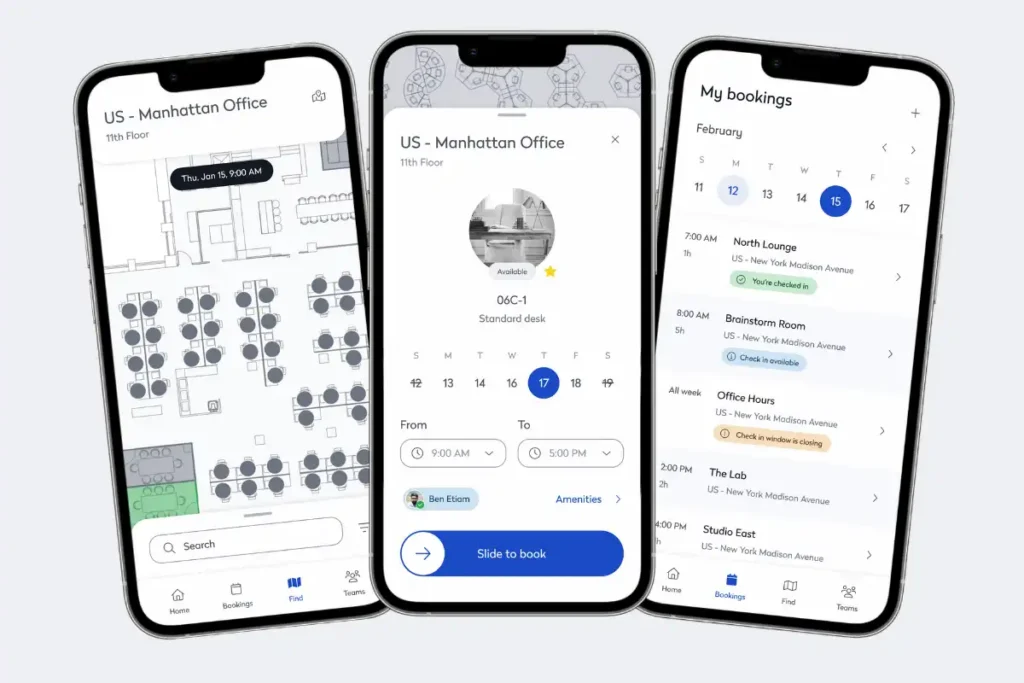
Key takeaways
- Workplace analytics transforms employee experience into measurable ROI. By tracking space usage, attendance patterns, resource availability, and engagement data, organizations can make targeted improvements that boost satisfaction and productivity.
- Combining quantitative data with employee feedback creates a complete EX picture. Merging analytics with surveys, sentiment analysis, and well-being metrics helps leaders address gaps before they impact morale and retention.
- Predictive and real-time analytics enable proactive workplace management. Anticipating trends, adjusting resources instantly, and benchmarking improvements over time ensure office spaces align with evolving employee needs.
Labor accounts for as much as 70% of total business costs, so investing in the employee experience will have high returns. But how exactly do you measure the return on investment (ROI)?
For large enterprises, optimizing the employee experience (EX) is a critical driver of engagement, productivity, and overall workplace satisfaction. As modern offices adopt flexible and hybrid work models, the need to understand and enhance the employee experience has grown exponentially.
Workplace analytics — tracking and analyzing data about space usage, employee preferences, and productivity — enables enterprise leaders to make data-driven decisions that create a more enjoyable and efficient work environment.
There are several ways workplace leaders can quantify the impact.
Employee experience: The foundation of successful modern workplaces
A positive employee experience is foundational to a company’s success, particularly in large enterprises where the workplace directly impacts engagement and retention. According to research, 83% of employees believe their experience is important to the company’s success, while only 41% feel their organization fully values it.
This gap between employee expectations and experience often translates into lower engagement and productivity, making it essential for enterprise leaders to put EX at the forefront of workplace strategies.
In modern offices, an excellent employee experience goes beyond perks and benefits. Today, EX is about employees’ holistic perception of their work environment — from the physical space to company culture, to the technology they use to the opportunities for growth. With the rise of hybrid work, large enterprises need insights into how employees interact with office spaces and resources.
Workplace analytics provides these insights, helping leaders build workplaces that support both business goals and employee satisfaction. This data-driven approach enables targeted improvements that can markedly enhance the overall employee experience.
The role of workplace analytics in boosting employee experience
Workplace analytics leverages data to improve the way employees interact with the office, providing valuable information on how spaces are used, how resources are allocated, and what employees need for an optimized work experience. This includes tracking desk bookings, meeting room usage, and foot traffic patterns, among other metrics, to ensure that office spaces align with employee needs and preferences.

Sentiment analysis, a key component of workplace analytics, is instrumental in identifying early indicators of dissatisfaction or other issues that could impact employee morale and productivity.
By monitoring employee feedback and communication channels, organizations can detect trends and patterns that may signal potential problems. This proactive approach enables timely interventions, addressing concerns before they escalate and fostering a more positive and productive work environment.
By merging data from disparate sources such as HR systems, productivity tools, and employee surveys, workplace leaders can get a more comprehensive view of the employee experience.
This approach empowers organizations to make decisions based on data that are both informed and impactful. By understanding the interplay between different aspects of the workplace, businesses can tailor their strategies to better meet the needs and expectations of their employees.
The application of predictive analytics also adds another layer to workplace analytics by proactively identifying potential risks and opportunities. Through the utilization of historical data and sophisticated algorithms, organizations can anticipate trends and make informed predictions about future employee satisfaction and retention.
This forward-thinking approach empowers businesses to implement strategies that not only enhance the current employee experience but also prepare for forthcoming challenges and opportunities.
Quantifying the employee experience (EX)
Given the substantial costs of attracting and retaining top talent, it makes sense that more organizations are making the employee experience (EX) a top priority. But these initiatives can be a tough sell to your leadership team if you don’t have the numbers to back up the conversation.
Employee experience is the sum of every interaction an employee has with an organization, from their first day to their last. It’s a holistic approach that considers how employees feel about their work environment, their job, and the organization.
EX has a significant impact on employee satisfaction, engagement, and productivity. To understand and improve EX, organizations need to look at workplace analytics, which provide the data needed to measure and monitor progress over time.
Workplace analytics allows enterprise leaders to answer key questions: How often are employees coming into the office? Are they utilizing collaborative spaces? Do they have the resources they need on the days they choose to work onsite? With answers to these questions, leaders can make informed adjustments that elevate the overall experience.
Quantifying EX also enables organizations to track the ROI of their workplace investments. For instance, if a recent redesign aimed at improving collaboration shows increased usage of meeting rooms, it validates the investment in planning spaces that encourage team interactions.
By monitoring and measuring EX, leaders can prioritize improvements that directly impact employee satisfaction and productivity.

Furthermore, the measurement of employee experience should be a continuous process, not a one-time event. Ongoing feedback mechanisms, such as pulse surveys, exit interviews, and performance reviews, provide a real-time view of the employee experience.
These methods enable organizations to remain responsive to changes in employee sentiment and to adjust their strategies accordingly.
Quantifying EX is not just about collecting data; it’s about using that data to create a roadmap for improvement. By understanding what drives satisfaction and engagement, organizations can implement targeted initiatives that resonate with their workforce.
Measuring what matters: 5 key employee experience metrics
To effectively elevate the employee experience, large enterprises should focus on specific metrics that directly reflect how employees engage with the workplace. Here are five essential metrics to track:
- Space utilization rates
This metric reveals how often office spaces, such as desks and meeting rooms, are being used. High or low utilization rates indicate whether the space is meeting employee needs or if adjustments are required to improve usage and reduce waste.
- Employee attendance patterns
Tracking when employees choose to work on-site provides insights into peak office days and can guide resource allocation. For example, high attendance on certain days may prompt the need for more collaborative spaces or support services.
- Resource availability and utilization
Data on the availability of resources like desks, meeting rooms, and shared equipment is essential for ensuring a smooth and efficient office experience. Workplace analytics tools can monitor resource usage to ensure employees have what they need to be productive.
- Employee engagement scores
While more qualitative, engagement scores from surveys or feedback loops provide insight into employee satisfaction with the work environment. Combined with analytics, these scores can reveal how well the office supports employee needs.
- Employee well-being
We might not think of wellness as an employee experience metric, but it’s a big one. And it’s obvious why: employees who are physically, mentally, or emotionally unwell miss more days of work and are less productive when at work. 52% of the workforce has at least one chronic health condition and many employees claim they don’t have the support that they need.
This inevitably leads to a loss in productivity, so it goes without saying that supporting your employees’ wellbeing has a direct impact on the bottom line. In CIPD’s 2023 Health and Wellbeing at Work report, it discovered that over a quarter (27%) of the 918 organizations it surveyed in the UK reported an average absence level of 10 days or more – nearly twice as many as in 2020.
For employees, frequent absences due to illness can result in increased stress and workload upon return, negatively impacting their overall job satisfaction and wellbeing.
By keeping a finger on the pulse of these metrics, enterprise leaders gain a holistic understanding of the workplace experience and can take actionable steps to optimize it.
Harnessing data for actionable insights: Tools and strategies
In using workplace analytics to drive action, enterprises need a combination of the right tools and strategies to convert raw data into actionable insights. They also need to simplify the complexity of the data and make it accessible to the people who need it.
Modern workplace management software offers an integrated approach to gathering, analyzing, and applying workplace data to improve EX. With tools for tracking desk and room bookings, monitoring occupancy, and understanding employee attendance, enterprise leaders can continuously assess and refine their workplace strategy.

Key strategies for harnessing workplace data:
- Use predictive analytics to anticipate needs: Predictive analytics can help forecast office attendance trends and resource needs based on historical data, allowing leaders to adjust space allocation and resource distribution before issues arise.
- Implement real-time monitoring for immediate adjustments: Real-time monitoring allows facilities teams to quickly respond to occupancy changes or resource demands, ensuring employees have the resources they need when they’re in the office.
- Integrate employee feedback loops: Combining quantitative data with qualitative feedback from employees provides a comprehensive picture of EX. Regular surveys and feedback forms allow employees to voice their needs, which can be directly compared with analytics data for a clearer picture of what’s working and what isn’t.
- Benchmark progress over time: Use workplace analytics to benchmark improvements in EX metrics over time, making it easier to track the success of initiatives and justify future investments.
Unlocking the power of workplace analytics
Workplace analytics is essential for transforming the employee experience, especially in large enterprises where managing a complex workforce across multiple sites can be challenging. By combining analytics with strategic planning, organizations can create work environments that are efficient, enjoyable, and adaptive to employees’ needs.
Eptura Engage, a workplace experience software, is designed to do just that. With features that track real-time occupancy, employee preferences, and resource availability, Eptura Engage helps leaders make informed decisions that improve employee satisfaction, optimize office use, and reduce operational waste.
Eptura Engage not only empowers employees with tools to personalize their workspace but also gives leaders valuable insights into how spaces are being used, which amenities are most valued, and where improvements can be made. This data-driven approach is the key to creating a modern office environment where employees feel valued and engaged.
Learn how to make office days the best days for your employees with Eptura Engage
By leveraging workplace analytics, large enterprises can cultivate an environment where employee experience is prioritized, leading to increased engagement, productivity, and long-term business success. Get in touch for a free demo of Eptura Engage.
Frequently asked questions
Workplace analytics is the process of collecting and analyzing data about space usage, employee behavior, and resource availability to create a more efficient and satisfying work environment. It helps leaders make informed changes that directly impact engagement and productivity.
Key metrics include space utilization rates, employee attendance patterns, resource availability, engagement scores, and well-being indicators. Tracking these over time helps quantify the success of workplace initiatives.
Predictive analytics uses historical and real-time data to forecast trends, such as peak office days or upcoming resource shortages. This allows organizations to plan proactively, ensuring employees always have the right tools and spaces when they need them.








